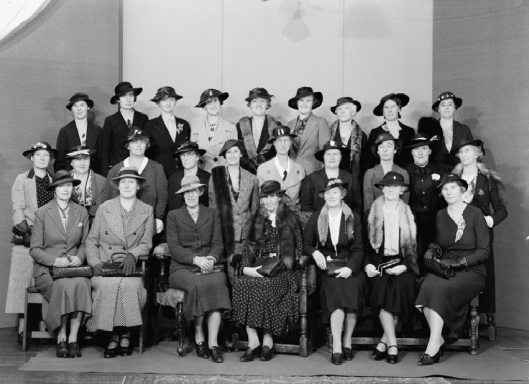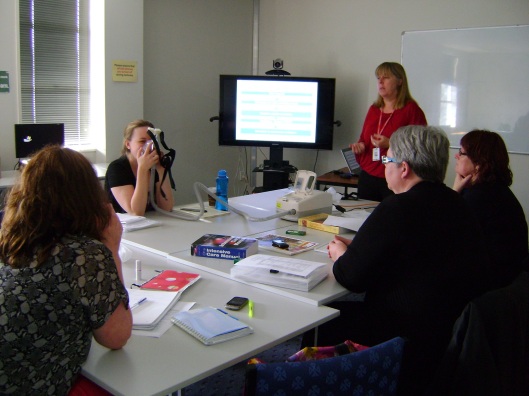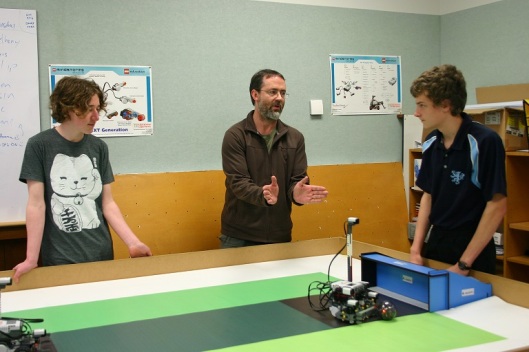Tags
1920s, 1970s, 1980s, 1990s, 2000s, 2010s, Christchurch, home science, medicine, mental health, nursing, public health, Wellington, women's studies

Some of New Zealand’s leading nurses of the 1920s, when the university attempted to set up a nursing diploma. They were photographed at the first conference of hospital matrons, held at Wellington Hospital in 1927. Image courtesy of the Alexander Turnbull Library, S.P. Andrew Ltd collection, reference 1/1-018313-F.
The University of Otago is perhaps most famous for its health science courses, but many people are unaware of its contributions to the largest of the health professions: nursing. There have been many twists and turns in the path to nursing education at Otago, which this blog post attempts to map.
Nurse training in this country started out with ad hoc programmes in various hospitals; it was an apprentice-style system, with nurses learning on the job and providing the bulk of the hospital workforce as they did so. In 1901 New Zealand introduced the registration of nurses. From that date general nurses could become registered after completing the required years of training and passing a state examination. Separate registration was later added for obstetric, psychiatric and psychopaedic nurses, along with another roll for nurses who had completed shorter training programmes, with greater restrictions on their practice (known initially as nursing aids, then community nurses, then enrolled nurses, then nurse assistants, then enrolled nurses again). The hospital-based education of nurses slowly improved, with more time dedicated to teaching from dedicated nurse tutors, but there was no higher education available for those tutors. Advancing education programmes became a priority for those who wished to increase the professional standing of nurses and improve the care they offered.
When Otago’s home science school started out in the 1910s, nurses took notice. In 1912 leading nurse Hester Maclean, who edited the nursing journal Kai Tiaki, published there the response of home science professor Winifred Boys-Smith to Maclean’s enquiries about the potential of the school’s new courses for women who intended to enter the nursing profession. Boys-Smith suggested that the diploma course would be ‘incalculably useful to a girl who wanted to become a really efficient hospital nurse, for it would enable her to obtain a sound and much more advanced knowledge of physiology, sanitary science and household economics, than she could afford the time to gain, while she was training at a hospital’. The courses might also benefit nurses already trained who wished to improve their qualifications: Boys-Smith hoped to attract ‘quite a number of the more intelligent nurses, who wish to make themselves especially efficient for the higher posts which offer’. It is unclear whether or not any nurses or potential nurses enrolled at the home science school at this point, but the courses there did become the core of a new venture a decade later.
In 1922, in response to various concerns about the state of nursing education, and advocacy from the Trained Nurses’ Association, the University of Otago council began planning a five-year nursing diploma. In consultation with the home science and medical schools, it approved a curriculum consisting of two years of university courses, two years of ‘ward work and general hospital training’, and a final year of specialised nursing education. An attractive feature of this programme was that it used existing courses at the home science school and hospital and would not require the council to employ any additional academic staff until the fifth year. Meanwhile, the government’s department of health was keen to see an advanced course for already-trained nurses, and suggested the fifth year of the proposed Otago diploma could become that course; it offered to send two senior nurses overseas to be educated as lecturers for the programme. Janet Moore headed to London and Mary Lambie to Toronto in 1925, with the fifth year/advanced programme scheduled to commence in 1926; meanwhile several women started the first years of the programme through the home science school.
Unfortunately, the scheme then fell apart due to a series of misunderstandings between the university and the health department. Neither had explicitly stated who was to pay the salaries of the specialist nursing lecturers. The university council assumed the health department’s involvement and support meant they would stump up the cash required, while the health department assumed the university would pay its own staff. Those council members who had only supported the project on the basis it would cost the university nothing stubbornly refused to commit any funding, even after the nurses’ association offered to pay a contribution. The health department proved equally stubborn over the matter. Admittedly the university was strapped for cash, but it is sad that a programme that could have changed the course of New Zealand nursing education collapsed over the cost of two salaries. Moore and Lambie approached Victoria College (later Victoria University of Wellington), where they got a more sympathetic response to a proposal for a short diploma course for already-registered nurses. The government proved more willing to offer funding for this course, which commenced in 1928 at Wellington Hospital, jointly supervised by Victoria, the health department and the hospital boards association. For 50 years the School of Advanced Nursing Studies, as it became known, was to provide New Zealand’s only advanced education for nurses. The first two students in Otago’s collapsed programme, who had already completed the first 4 years, went on to complete the new Wellington course. One of them, Winifred Fraser, applied to Otago for a diploma of nursing, becoming the one and only person awarded that qualification. Most of the other women partway through their course switched to home science.
After this unfortunate episode, the University of Otago kept out of nursing education for many decades. Meanwhile, dissatisfaction with New Zealand nursing education remained, with high attrition rates, a failure to keep up with new developments and a continuing focus on student nurses as a labour force rather than learners. In 1970 the government approached the World Health Organisation, which appointed Helen Carpenter (director of the University of Toronto’s nursing school) to review the current system. Her report (An improved system of nursing education for New Zealand) led to major reforms. The education of registered nurses shifted from the health sector to the tertiary education sector. Commencing at Wellington and Christchurch in 1973, technical institutes around the country established nursing schools, and registered nurse programmes at hospitals were gradually phased out (though hospitals continued to train community/enrolled nurses). The technical institutes also later developed advanced diploma courses in various clinical fields, taking over the role of the School of Advanced Nursing Studies.
One of Carpenter’s recommendations was that a proportion of nurses should be educated to a still higher level, through universities. She suggested that Otago’s preventive and social medicine department, along with the education departments at Victoria, Massey and Canterbury, could start by appointing a nurse to their academic staff, with a view to building up nursing research and later courses. Otago’s medical faculty proved largely supportive of the idea, but over the next decade various proposed schemes came to nothing. Meanwhile, Victoria and Massey began offering a few BA papers in nursing studies. Proposals from Otago included a diploma in nursing administration, and later a basic-level bachelor’s degree, but neither made it past the University Grants Committee. In 1979, faced with various proposals for new nursing courses, the UGC appointed a special committee on nursing education, which recommended turning down Otago and Massey’s proposals for basic degrees, and another from Auckland for a post-basic bachelor’s degree. Victoria, it suggested, could develop its existing programme into a full nursing degree, complete with clinical education, while Massey should continue its existing courses. Victoria approached Otago’s Wellington clinical school to see if they might cooperate in an undergraduate nursing degree. That scheme got quite advanced but eventually fell through due to the government’s unwillingness to supply funding. Victoria’s nursing programme went into abeyance for a while in the early 1980s, but it later built up a postgraduate school. There were many differing opinions about university-level nursing education but it was, generally, finance that prevented many a dreamed-of programme from getting going. In Dunedin, any sense of urgency for an undergraduate programme that would lead to nursing registration ended once the Otago Polytechnic opened its nursing school in 1984.
Of course, nurses did enrol in a variety of other University of Otago courses. A good example is nursing academic Beverley Burrell, who trained as a nurse at Dunedin Hospital in the 1970s. After developing an interest in education through the playcentre movement, she enrolled in education courses at the university, going on to complete a BA and MA in women’s studies. There was a close synergy between her nursing experience and her university study.

Robyn Beach leading a class in the ‘nursing – high acuity’ paper in the Centre for Postgraduate Nursing Studies premises in Oxford Terrace, Christchurch, 2012. Image courtesy of the Centre for Postgraduate Nursing Studies.
In the end, it was on the Christchurch campus that Otago finally got a successful programme specifically for nurses off the ground. The medical school there offered a wide range of postgraduate courses, undertaken by a variety of health professionals, including nurses; for instance, many nurses completed public health and mental health postgrad qualifications. With the government injecting money into ongoing clinical training for healthcare workers, and increasing demand for nursing-specific courses, in 1997 the Centre for Postgraduate Nursing Studies opened. Initially hosted by Christchurch’s Department of Public Health and General Practice, it grew quickly and soon became an independent centre. Christchurch nurses had long wanted a local alternative to the postgraduate nursing programmes offered by Massey and Victoria universities, but flexible teaching methods, including block courses and distance education, meant the new Christchurch courses soon had students from all over the South Island, and a few from further afield. Starting out with papers on nursing practice and mental health nursing practice, the centre soon developed a range of papers, some generic and others in specialist fields of practice. Students could complete a postgraduate diploma or master’s degree in health sciences, endorsed in nursing, or various shorter certificate courses in specialist fields; the centre also offered PhDs. From 2006 a new master of health sciences option allowed an alternative to the papers plus thesis requirement: students could now complete papers and a ‘clinically applied research practicum’ for an endorsement in ‘nursing – clinical’. This was an important development because it met the clinically-oriented master’s degree requirement for those who applied to the New Zealand Nursing Council for registration as a nurse practitioner, a new level of practice which included prescribing rights.

Beverley Burrell teaching a course for the ‘nursing – leadership and management’ paper in 2011. The class was held in the Philatelic Society rooms, one of many temporary premises used after the usual venues were closed due to earthquake damage. Image courtesy of the Centre for Postgraduate Nursing Studies.
As the nursing centre grew, so did its research. Staff attracted considerable research funding, including from the Health Research Council, and also benefited from Tertiary Education Commission funding targeted at developing research capability in nursing and other health professions which had not done well under the PBRF system. In 2008 Lisa Whitehead received the university’s early career award for distinction in research, recognising her achievements in research on the management of long-term conditions (a field of particular interest for the nursing centre). As its research capability grew, the centre attracted more PhD students from both New Zealand and overseas; by 2012 it had 10 PhD candidates enrolled among its 350 students and had the largest postgraduate programme on the Christchurch campus.

The Addington Raceway was another stand-in venue for nursing courses following the Christchurch earthquakes. Here it is set up ready for clinical teaching for the ‘health assessment and advanced nursing practice’ paper in 2011. Image courtesy of the Centre for Postgraduate Nursing Studies.
The nursing centre has never been short of initiative and has introduced a variety of new courses to meet needs in the health sector. In 2016 it enrolled the first students in perhaps its most exciting venture to date: a new master of nursing science degree, which allows people with a bachelor’s degree in any discipline to complete the professional education required for registration as a nurse in a concentrated two-year programme. While this type of programme has been available in North America for decades and in Australia for several years, it is the first qualification of its type in New Zealand and required new regulations from the Nursing Council. Finally, some 90 years after the first ill-starred attempt, the University of Otago is offering a course which leads to the registration of nurses!



